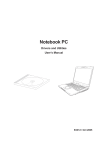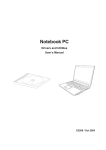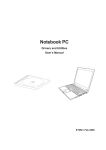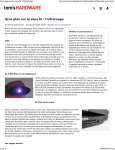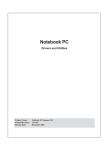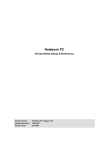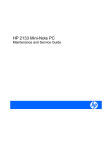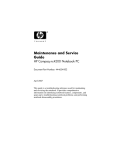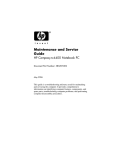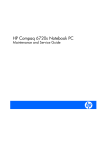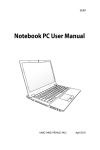Download VGA Driver Setup
Transcript
Notebook PC Drivers and Utilities User’s Manual E2092 / April 2005 Table of Contents Support CD Support CD for Microsoft Windows .................................................................................... 5 New Operating System Installation .................................................................................... 5 Drivers for Microsoft Windows ........................................................................................... 5 Device Manager ............................................................................................................... 10 VGA Driver ........................................................................................................................... 13 VGA Driver Setup (Model 1 – Intel) .................................................................................. 14 VGA Driver Setup (Model 2 – ATI) ................................................................................... 15 VGA Driver Setup (Model 3 – SiS) ................................................................................... 16 VGA Driver Setup (Model 4 – NVIDIA) ............................................................................ 17 VGA Driver Settings ......................................................................................................... 18 ATK0100 Driver (ACPI) ........................................................................................................ 21 ATK0100 Driver Setup ..................................................................................................... 22 Audio .................................................................................................................................... 23 Audio Setup ..................................................................................................................... 24 CMOS Camera ..................................................................................................................... 25 Camera Driver Setup ....................................................................................................... 26 Using the Camera ............................................................................................................ 27 Microsoft Windows ...................................................................................................... 27 GameFace Enhanced Display Driver ................................................................................. 29 GameFace Driver Setup (selected models) ..................................................................... 31 INF Update (Intel) ................................................................................................................ 31 INF Update Driver Setup .................................................................................................. 32 INTEL Calexico (Wireless LAN) ......................................................................................... 33 Wireless LAN Driver Setup - Calexico2 (2915ABG) ........................................................ 34 Wireless LAN Driver Setup - Calexico2 (2200BG) ........................................................... 35 Wireless LAN Utility Introduction ................................................................................. 36 ASUS Wireless LAN ............................................................................................................ 36 ASUS WLAN Driver Setup ............................................................................................... 38 ASUS WLAN Utility Setup ................................................................................................ 39 ASUS WLAN Utility Quick Start .................................................................................. 40 LAN ....................................................................................................................................... 43 LAN Driver Setup ............................................................................................................. 44 Configuring your LAN ....................................................................................................... 45 Joining a Domain or Workgroup (Windows XP) .......................................................... 45 Viewing Your Network ................................................................................................. 47 2 Support CD Modem .................................................................................................................................. 49 Modem Driver Setup ........................................................................................................ 50 Modem Configuration .................................................................................................. 50 RICOH ................................................................................................................................... 52 Ricoh Driver Setup ........................................................................................................... 54 ChkMail ................................................................................................................................ 56 ChkMail Setup .................................................................................................................. 58 GameFace ............................................................................................................................ 58 GameFace Utility ............................................................................................................. 60 GameFace Live Features ................................................................................................ 61 Multi-user audio/video communication ........................................................................ 61 Pause and disable video functions ............................................................................. 61 Sound detection .......................................................................................................... 61 User interface .............................................................................................................. 62 Getting started ............................................................................................................ 62 Launch GameFace ..................................................................................................... 62 Local Mode ................................................................................................................. 64 GameFace Setup ............................................................................................................. 64 Server Mode .................................................................................................................... 65 Activate Server ............................................................................................................ 66 Refresh Server List ..................................................................................................... 66 Connect ....................................................................................................................... 66 Pause .......................................................................................................................... 66 LAN Mode ........................................................................................................................ 67 Displaying GameFace in Games ..................................................................................... 68 WAN Mode ....................................................................................................................... 68 ASUS OSD ...................................................................................................................... 69 Frequently Asked Questions ............................................................................................ 70 LiveUpdate ........................................................................................................................... 72 LiveUpdate Setup ............................................................................................................ 74 Using LiveUpdate ............................................................................................................. 75 Norton Internet Security ..................................................................................................... 76 Norton Internet Security Setup ......................................................................................... 78 Internet Proxy Settings ................................................................................................ 80 Internet Security Main window .................................................................................... 81 Internet Security Features ........................................................................................... 82 3 Support CD Power4 Gear ........................................................................................................................ 82 Power4 Gear Setup ......................................................................................................... 84 Benefits of Power4 Gear .................................................................................................. 85 Power4 Gear Interface ................................................................................................ 85 Program Icons ............................................................................................................. 86 Power4 Gear ............................................................................................................... 87 Renaming Settings ...................................................................................................... 87 Power4 Gear Configuration ........................................................................................ 87 Power Saving Details .................................................................................................. 88 NB Probe .............................................................................................................................. 88 NB Probe Setup ............................................................................................................... 90 Using NB Probe ............................................................................................................... 91 Starting NB Probe ....................................................................................................... 91 Using NB Probe Monitoring ........................................................................................ 92 TouchPad ............................................................................................................................. 94 Touchpad Setup ............................................................................................................... 96 Synaptics® TouchPad Features ....................................................................................... 97 Tap on the Pad Instead of Pressing the Buttons ......................................................... 97 Drag Icons, Windows and Other Objects without Using Buttons ................................ 97 Adjust the Overall Touch Sensitivity ............................................................................ 98 Customize Buttons and Taps ...................................................................................... 98 Prevent Accidental Pointing While Typing ................................................................... 99 Scroll Through A Document without Using Scroll Bars ............................................... 99 Zoom In/Out and Pan on Documents ......................................................................... 99 Move the Pointer Long Distances ............................................................................. 100 Fine Tune the Pointer Movement .............................................................................. 100 Accessories ............................................................................................................... 100 More About the TouchPad ......................................................................................... 100 Property Pages .............................................................................................................. 100 Scrolling Properties Page ......................................................................................... 101 Tap Zones Properties Pages ..................................................................................... 102 More Features Properties Page ................................................................................ 103 Button Actions Properties Page ................................................................................ 104 Touch Properties Page .............................................................................................. 105 Edge Motion Properties Page ................................................................................... 106 Frequently Asked Questions .......................................................................................... 107 Video Security ................................................................................................................... 108 WinFlash ............................................................................................................................ 110 Video Security Setup ....................................................................................................... 111 WINFLASH Setup .......................................................................................................... 113 Using WINFLASH .......................................................................................................... 113 4 Support CD Support CD for Microsoft Windows The Notebook PC you purchased may or may not be preloaded with an operating system. The support CD included with this Notebook PC provides all the necessary drivers and utilities in order for you to use your Notebook PC with Microsoft® Windows® XP (referred to as “Windows” in this User’s Manual). The levels of hardware and software support may vary depending on the installed operating system. Operating systems not pre-installed on this Notebook PC may produce different results than the ones described in the provided user’s manuals. If your Notebook PC is not preloaded with any operating system, or you want to install another operating system other than the preloaded one, the following pages will give step-by-step installation procedures for typical system configurations under the Windows® operating system. For application usage, please see the online help provided with each of the applications after installation. The following are contents of a typical support CD. Variations may be found for each territory or language. If the autorun menu does not appear, double clicking the CD-ROM disc drive icon in “My Computer” (may be the (D:) drive or (E:) drive on hard drives with two partitions) or running SETUP.EXE (through Start menu “Run...”) located in the root of the support CD, will bring up the autorun menu. New Operating System Installation If you install a new operating system on your Notebook PC, there will be many hardware devices without drivers. Use the provided support CD to correct this problem. Drivers for Microsoft Windows Next page gives descriptions of each support CD item. Due to ongoing improvements in the support CD, there may be some differences between this User’s Manual and your support CD. The names in quotations are the actual driver names displayed in the System Properties of MS Windows. Windows cannot contain all the device drivers from every manufacturer, with every update; therefore the provided support CD will contain the best driver for your built-in devices and should be used in place of any Windows default drivers. Some drivers may already be provided in Windows. If you have any problems with these drivers, visit the Microsoft Windows Update site. A link is provided in Microsoft Windows Explorer under “Tools.” The exact controller and driver will vary by model and territory. 5 Support CD Software Drivers VGA (Display) (Driver depends on model) “Intel(R) 82852/82855 GM/GME” or “ATI MOBILITY RADEON 9700” or “SiS M760GX” or “NVIDIA GeForce Go 6200” Installing the VGA driver first will make viewing other setup screens much easier. This installs display drivers for your operating system in order to properly use the Notebook PC’s built-in graphics controller and to provide optimal display features. Once the display driver is installed, you can change your display’s resolution and color through Display Properties. This device is shown under Windows Device Manager “Display adapters.” ATK0100 “ATK0100 ACPI UTILITY” Utility This utility is required for special utilities provided in the support CD. This installs drivers for the Notebook PC’s Advanced Configuration and Power Interface (ACPI) for features utilizing power management functions. This device is shown under Windows Device Manager “System devices.” Audio “Realtek AC’97 Audio” Driver This installs audio drivers for your operating system in order to properly use the Notebook PC’s built-in sound controller. All audio functions are configured through Windows and help can be located within Windows documentation or Windows help files. This device is shown under Windows Device Manager “Sound, video and game controllers.” CMOS Camera “BisonCam, USB2.0” (on selected models) Installs a camera driver in order to enable the optional built-in camera on top of the LCD panel. This device is shown under Windows Device Manager “Imaging devices.” GameFace Enhanced Display Driver (on selected models) Installs GameFace driver. GameFace lets you talk to and see your friend on the remote computer (video conferencing) even when you are playing a full-screen game. INF Update This installs Windows support files for advanced features in new chipsets. Intel Calexico2 / ASUS WLAN (Depends on model) “Intel(R) PRO/Wireless 2200BG Network Connection” or “Intel(R) PRO/Wireless 2915ABG” or “ASUS WLAN” Driver Required on models with internal wireless LAN. Installs the required network driver for the Notebook PC’s optional internal wireless LAN controller. If you purchased the optional internal wireless LAN, you need to install this driver. If you did not purchase the optional internal wireless LAN, you cannot install this driver. This device is shown under Windows Device Manager “Network Adapters.” 6 Support CD LAN “Realtek RTL8139/810x Family Fast Ethernet NIC” Driver Installs the required LAN driver for the Notebook PC’s built-in PCI Fast-Ethernet controller. Fast-Ethernet supports both 10 Base-T or 100 Base-TX networks at half or full duplex. This device is shown under Windows Device Manager “Network Adapters.” Modem “AC97 SoftV92 Data Fax Modem with SmartCP” Driver Installs the necessary driver in order for your operating system to have the correct files for the Notebook PC with built-in modem and drivers for integration with the internal audio. With third-party software, fax and speaker phone capabilities are possible using this Notebook PC. This device is shown under Windows Device Manager “Modems.” RICOH “Ricoh R/RL/5C476(II) or Compatible CardBus Controller” Driver A version of this driver is provided by Microsoft in its Windows XP operating system. The support CD includes this driver called for added enhancements for Windows XP and other Windows versions. This device is shown under Windows Device Manager “PCMCIA adapters.” Software Utilities AFLASH2 DOS Utility This utility allows you to upgrade your Notebook PC’s BIOS in DOS mode. You enter DOS mode by booting to a DOS system on a floppy disk, CD, or USB drive instead of entering the Windows operating system. AFLASH2.EXE can be found in the “Aflash” folder of the support CD. (This utility is not shown in this User’s Manual.) Check Mail Utility Installs Check Mail utility to monitor and notify you of incoming email messages waiting in your Microsoft® Outlook or Outlook Express Inbox. (This utility may or may not be compatible with other email applications.) GameFace Utility (on selected models) Installs GameFace utility. GameFace lets you talk to and see your friend on the remote computer (video conferencing) even when you are playing a full-screen game. Requires “GameFace Enhanced Display Driver.” LiveUpdate Utility This utility helps you easily upgrade your Notebook PC’s BIOS through an Internet connection. Norton Internet Secruity 2005 Utility Installs Norton Internet Security to provide comprehensive virus prevention, threat detection, and repair software for your computer. It automatically detects and repairs known viruses. Norton Internet Security 7 Support CD detects viruses and other potential risks in instant messenger attachments as well as in email messages, Internet downloads, and other files. Easy updating of the virus definitions over the Internet keeps Norton Internet Security prepared for the latest threats. Norton Internet Security also includes: Security protection features, Personal Firewall, Spam filtering features, and Ad blocking features. You may skip this software if you have your own antivirus software. Power4 Gear Utility Power4 Gear is a custom utility designed for this Notebook PC that allows you to use predefined or user defined values for multi-selectable power saving modes or “gears”. You can “shift” between the “gears” using the taskbar icon or the keys above the keyboard. NB Probe Utility Installs NB Probe utility to monitor the Notebook PC’s CPU temperature and other resources. This is an optional software to help you better manage your Notebook PC’s resources. TouchPad “Synaptics PS/2 TouchPad” Utility Shown under Windows “Mice and other pointing devices.” Installs “Synaptics® TouchPad” utility. The Notebook PC already supports built-in or externally connected keyboard and PS/2 mouse devices. However, the provided device driver will provide enhancements and features to the TouchPad to increase the functionality of the TouchPad. For detailed information, see the Software Reference in the next section. To access help, right-click the TouchPad icon on the taskbar and select Help. Video Security Utility (on selected models) Installs Video Security utility. Video Security lets you use the optional built-in camera as a security camera and record activities within its view. Requires “GameFace Enhanced Display Driver.” WinFlash Utility Installs a BIOS update utility for Windows so that you can conveniently update your Notebook PC’s BIOS without having to restart your Notebook PC in DOS mode. 8 Support CD Drivers Provided in Windows XP If you have any problems with these drivers, visit the Microsoft Windows Update site. A link is provided in Microsoft Windows Explorer under “Tools.” 1394 (Already supported in Windows XP) This driver is provided by Microsoft in its Windows XP operating system. This device is shown under Windows Device Manager “IEEE 1394 Bus host controllers”. AGP (Already supported in Windows XP) This function is already supported in Windows XP. The support CD also includes a version of this utility for other Windows versions. Installation will not be possible under Windows XP. This device is shown under Windows Device Manager “System devices”. PCMCIA (Already supported in Windows XP) This driver is provided by Microsoft in its Windows XP operating system. This device is shown under Windows Device Manager “PCMCIA adapters”. USB 2.0 (Already supported in Windows XP SP1 & Windows 2000 SP4) This driver is provided by Microsoft in its Windows operating system. The support CD also includes a version of this driver for Windows 98 SE or Windows ME. This driver is not required for Windows 2000 or Windows XP and installation will not be possible. This device is shown under Windows Device Manager “Universal Serial Bus controllers”. 9 Support CD Device Manager “Device Manager” will be used in many device driver installation, upgrade, and verification processes. 1. Click “start” button. 2. Click “My Computer” icon. 3. Click “View system information” link. Hardware Devices After installing your operating system, several question marks will appear under “Other devices” representing hardware devices that Windows cannot recognize. After installing the drivers from the provided support CD. Those question marks will go away. 4. Click “Hardware” tab. 5. Click “Device Manager” button. 10 Software Drivers Software Drivers VGA Driver Software Drivers (It is necessary to install the VGA driver first in order to see other setup screens in their proper sizes.) Topics Covered: VGA Driver Setup Display Settings for Windows XP Taskbar Menu Before After Model 1: Model 2: Model 3: Model 4: (Screens and drivers may vary depending on your model and operating system.) 13 VGA Driver Setup (Model 1 – Intel) Your VGA driver will depend on the Notebook PC model purchased. Running setup will give you the following wizard. Software Drivers 1. On the “Welcome” screen, click Next after reading the message. 2. On the “License Agreement” screen, click Yes after reading. 3. When setup is complete, select “Yes...” and click Finish in order to restart Windows with a higher screen resolution*. * Windows may have already provided the highest screen resolution support for this graphics controller. 14 Before VGA drivers are installed, graphics functions are limited. VGA Driver Setup (Model 2 – ATI) Software Drivers Your VGA driver will depend on the Notebook PC model purchased. Running setup will give you the following wizard. 1. On the “Welcome” screen, click Next after reading the message. 2. On the “License Agreement” screen, click Yes after reading. 3. On the “Select Components” screen, click Express. 4. When setup is complete, select “Yes...” and click Finish in order to restart Windows with a higher screen resolution*. * Windows may have already provided the highest screen resolution support for this graphics controller. 15 VGA Driver Setup (Model 3 – SiS) Your VGA driver will depend on the Notebook PC model purchased. Running setup will give you the following wizard. Software Drivers 1. On the “Welcome” screen, click Next after reading the message. 2. On the “Setup Type” screen, click Next to use the default settings. 3. On the “Select Program Folder” screen, click Next to use the default folder or enter another folder name. 4. On the “Start Copying Files” screen, click Next after verifying the settings or click back to make changes. 5. When setup is complete, select “Yes...” and click Finish in order to restart Windows with a higher screen resolution*. * Windows may have already provided the highest screen resolution support for this graphics controller. 16 VGA Driver Setup (Model 4 – NVIDIA) Software Drivers Your VGA driver will depend on the Notebook PC model purchased. Running setup will give you the following wizard. 1. On the “Welcome” screen, click Next after reading the message. 2. On the “Windows Logo testing” screen, click Continue Anyway because the manufacturer has already tested this driver for this Notebook PC. 3. When setup is complete, select “Yes...” and click Finish in order to restart Windows with a higher screen resolution*. * Windows may have already provided the highest screen resolution support for this graphics controller. 17 VGA Driver Settings After VGA driver installation (Model 2 - ATI) Make screen resolution settings in “Display Properties”. Higher resolutions may be available but panning will occur if you surpass the display panel’s specifications. Make screen resolution settings in “Display Properties”. Higher resolutions may be available but panning will occur if you surpass the display panel’s specifications. Left click the taskbar icon for shortcuts to display settings. Left click the Right click the taskbar icon taskbar icon for for shortcuts to display quick resolution settings. settings. Software Drivers After VGA driver installation (Model 1 - Intel) 18 VGA Driver Settings (Cont.) After VGA driver installation (Model 4 - NVIDIA) Make screen resolution settings in “Display Properties”. Higher resolutions may be available but panning will occur if you surpass the display panel’s specifications. Make screen resolution settings in “Display Properties”. Higher resolutions may be available but panning will occur if you surpass the display panel’s specifications. Software Drivers After VGA driver installation (Model 3 - SiS) The taskbar icon is not shown by default. You can enable it through Windows “Advanced” display properties. Right click the taskbar icon for shortcuts to display settings. Left or Right click the taskbar icon for shortcuts to display settings. 19 Software Drivers 20 ATK0100 Driver (ACPI) Software Drivers (Required driver) Topics Covered: ATK0100 Driver Setup Before After (Screens and drivers may vary depending on your model and operating system.) 21 ATK0100 Driver Setup This driver requires that you manually install it from Device Manager. No software operation is required. Software Drivers 22 1. Double click Unknown device. 2. Click Reinstall Driver. 3. Select “No...” and click Next. 4. Select “Install from...” and click Next. 5. Browse to your operating system folder in the “ATK0100” folder and click Next. 6. Click Finish when setup is complete. 7. Click Close to close the properties window. Audio Software Drivers (Required driver) Topics Covered: Audio Setup The notebook PC has built-in speakers and microphone, however, external audio accessories may be used. External audio connections will disable the notebook PC’s relevant built-in audio device (mic and/or speakers). Before After (Screens and drivers may vary depending on your model and operating system.) 23 Audio Setup Running setup will give you the following wizard: Software Drivers 1. Click Next to begin setup. 24 2. When setup is complete, select No... and click Finish in order to install other items. CMOS Camera Software Drivers (Required driver on selected models) Topics Covered: Camera Driver Setup Using the Camera After the driver and utility is installed, you may begin using any camera or video software on the Notebook PC. (No previous category in Device Manager) After Screens will vary depending on your operating system but the contents should be the same. 25 Camera Driver Setup If you purchased the Notebook PC with the built-in camera, you will need to install this driver and utility. Running setup will give you the following wizard: Software Drivers 26 1. On the “Choose...Language” screen, select the language you wish to install and click OK. 2. On the “Welcome” screen, click Next to begin installing the driver. 3. On the “Windows Logo warning” screen, click Continue Anyway because this driver has been fully tested by the manufacturer for this Notebook PC. 4. On the “Setup Complete” screen, select “No...” and click Finish in order to install other items before restarting. Using the Camera Software Drivers Microsoft Windows In “My Computer”, you will see BisonCam. Double click on it to begin using it with Windows native camera software. With Windows native camera software, you can see yourself in real-time. Click Take a new picture to capture your image to a file on your hard drive. 27 Software Drivers 28 GameFace Enhanced Display Driver Software Drivers (Required driver for GameFace utility on selected models) Topics Covered: GameFace Driver Setup After the driver and utility is installed, you may begin using any camera or video software on the Notebook PC. (No previous category in Device Manager) After (Screens and drivers may vary depending on your model and operating system.) 29 GameFace Driver Setup (selected models) Running setup will give you the following wizard: Software Drivers 30 1. On the “Welcome” screen, click Next after confirming this is what you want to setup.. 2. Click Install to begin copying files. 3. After the files are installed, click Finish. 4. When setup is complete, select “No...” and click Finish in order to install other items. INF Update (Intel) Software Drivers (Required driver) Topics Covered: INF Update Driver Setup (Screens and drivers may vary depending on your model and operating system.) 31 INF Update Driver Setup Running setup will give you the following wizard: Software Drivers 32 1. On the “Welcome” screen, click Next after confirming this is what you want to setup. 2. On the “License Agreement” screen, click Next after reading. 3. On the “Readme” screen, click Next after reading. 4. Setup is now complete, select “No...” and click Finish in order to install other items. INTEL Calexico (Wireless LAN) Software Drivers (Required driver on selected models) Topics Covered: Wireless LAN Driver Setup Wireless LAN Utility Setup Wireless LAN Utility Quick Start An optional access point is required to setup a wireless network for the Notebook PC to connect to. Before After or 2915ABG (Screens and drivers may vary depending on your model and operating system.) 33 Wireless LAN Driver Setup - Calexico2 (2915ABG) Driver depends on model. Running setup will give you the following wizard: Software Drivers 34 1. On the “Autorun” screen click Install Software. 2. On the “Welcome” screen click Next after reading the message. 3. On the “Agreement” screen, click Next after selecting “I accept...” 4. On the “Select Components” screen, click Next to use the default settings. 5. On the “Ready” screen click Install to begin the installation. 6. On the “Wizard Complete” screen, click Finish to exit the installation wizard. Wireless LAN Driver Setup - Calexico2 (2200BG) Software Drivers Driver depends on model. Running setup will give you the following wizard: 1. On the “Autorun” screen click Install Software. 2. On the “Agreement” screen, click Next after selecting “I accept...” 4. On the “Install default components” screen, click OK to use the default settings. 3. On the “Setup Type” screen, click Next to use the default settings. 5. Wait while components are installed. 6. When complete, click Ok to exit the installer. 35 Wireless LAN Utility Introduction After installing the Wireless driver and utility, the utility will automatically start with Windows. If you need to start it manually, you can launch the utility using the desktop icon or through Windows start. You will need to make some wireless LAN settings before being able to use your wireless connection. Software Drivers After installation, you will have several options available through the icon on the task bar. Status - View connection status here. Details - View available access point information here. 36 Configure - Make a new profile to save specific settings for use in different WLAN networks. ASUS Wireless LAN Software Drivers (Required driver an selected models) Topics Covered: ASUS WLAN Driver Setup ASUS WLAN Utility Setup ASUS WLAN Utility Quick Start An optional access point is required to setup a wireless network for the Notebook PC to connect to. Screens will vary depending on your operating system but the contents should be the same. 37 ASUS WLAN Driver Setup Running setup will give you the following wizard: Software Drivers 38 1. Click Next after reading the “Welcome” screen. 2. Click Next after reading the “Information” screen. 3. On the “Select Program Folder” screen, click Next to continue or you may first change the folder. 4. Setup is now complete, select “No...” and click Finish in order to install other items. ASUS WLAN Utility Setup Software Drivers After installing driver, you need to install the wireless utility. 1. Click Next after reading the “Welcome” screen. 2. Click Next after reading the “Information” screen. 3. On the “Choose Destination Location” screen, click Next to continue or you may first change the destination folder. 4. On the “Select Program Folder” screen, click Next to continue or enter a different folder name. 39 ASUS WLAN Utility Setup (Cont’) Software Drivers 5. Click Finish on the “Setup Complete” screen. 6. Select to use “...ASUS Utilities...” for added features while using the wireless LAN device. ASUS WLAN Utility Quick Start After installing the ASUS WLAN driver and utility, the utility will automatically start with Windows. If you need to start it manually, you can launch the utility using the desktop icon or through Windows start. You will need to make some wireless LAN settings before being able to use your wireless connection. (Right-Click Menu) 1. Right-click the ASUS WLAN icon and select “Wireless Settings” 40 2. Set the Network Name (SSID) to the same name as the SSID set in your wireless access point. Software Drivers ASUS WLAN Utility Quick Start (Cont.) 3. Use “Site Survey” if you don’t know the name of your access point(s). 4. Encryption settings must also match those set in the access point. Talk with your network administrator if necessary. Click Apply to save your settings 5. Check the “Status” page to see the “Association State”. It should show “Connected xx:xx:xx:xx:xx:xx”. 6. You can also see the connection quality on the “Connection” page. Click OK to exit the utility. 41 Software Drivers 42 LAN Software Drivers (Required driver) Topics Covered: LAN Driver Setup Configuring your LAN Connect the LAN port to a network to begin using the built-in LAN function. Before After (Screens and drivers may vary depending on your model and operating system.) 43 LAN Driver Setup You will see a “Found New Hardware Wizard” if you device requires setup. If not your driver may already be installed by Windows. If your device is not working, you can manually install the driver as follows: Software Drivers 1. Run “Setup” and click Next on the Welcome screen. 44 2. When complete, click Finish to exit the installation wizard. Configuring your LAN Software Drivers Joining a Domain or Workgroup (Windows XP) (1) Click Start and My Computer. (2) Click View system information. You cannot use spaces or symbols in the computer name. In the example here, a warning is given when trying to use “Notebook PC”. You can use the single word “Notebook” instead. (3) Your computer name, workgroup or domain information is shown here. Click Change to view options. 45 Joining a Domain or Workgroup (Cont’) Software Drivers (4a) Domain: The primary server in the domain will perform routing functions and security verifications for your computer. Select Domain and enter an existing domain you wish to join. NOTE: After clicking “OK”, you will be asked for the Domain Controller’s Administrator password to join the domain in Windows XP. (4b) Workgroup: If your network does not have a domain or you are not authorized to join a domain, select Workgroup and type in an existing name or create your own (by typing an unused workgroup name) Administrator Name or Password not accepted: You cannot login with the Administrator name and use one password, then use the Administrator name with another password to add to a domain. You must login using another name. See Windows documentation to “Add New User” from User Accounts in the Control Panel. 46 Software Drivers Joining a Domain or Workgroup (Cont’) (5) After you restart your computer, you should see some contents through Entire Network. Viewing Your Network (6) Clicking on “My Network Places” will display networks which you have installed protocols for. Clicking a network protocol such as “MS Windows Network” will display all the servers available under that protocol. 47 Software Drivers 48 Modem Software Drivers (Required driver) Topics Covered: Modem Driver Setup Modem Configuration Connect a telephone cable from your Notebook PC to a telephone jack. Before After (Screens and drivers may vary depending on your model and operating system.) 49 Modem Driver Setup Running setup will give you the following wizard: Software Drivers 1. On the “Welcome” screen, click Next after reading. 2. Setup is now complete, click OK to exit the wizard. Modem Configuration Use New Connection Wizard in “Network Connections” to start the configuration wizard to your modem. The New Connection Wizard also allows configuration for other communication devices (if available) such as LAN, ISDN, ADSL, or Bluetooth. 1. From “My Network Places”, click “View network connections and then “Create a new connection”. 50 2. Select “Connect to the Internet” and click Next. Software Drivers Modem Configuration (Cont’) 3. Select “Set up my connection manually” and click Next. 4. Select “Connect using a dialup modem” and click Next. 5. Select your modem and click Next. 6. Enter any name to represent your ISP. 7. Enter the dial up number for your ISP. 8. Selection one of the security preferences and click Next. 51 Modem Configuration (Cont’) Software Drivers 9. Enter your ISP account name and password and click Next. 11. When you click on the link, the connection window will show. Click Dial to connect to your ISP. 52 10. Select “Add a shortcut...” and click Finish. RICOH Software Drivers (Optional driver) Topics Covered: Ricoh Media Driver Setup SD/MMC MS / MS Pro After the memory reader driver is installed, you can read or write to various memory types. See the hardware manual for information on supported memory types. Driver already provided in Windows XP (Screens and drivers may vary depending on your model and operating system.) 53 Ricoh Driver Setup Running setup will give you the following wizard: Software Drivers 54 1. On the “Welcome” screen, click Next after confirming this is what you want to setup. 2. On the “Ready to install” screen, click Install to begin copying files to your system. 3. When complete, click Finish. 4. Setup is now complete, select “No...” and click Finish in order to install other items. Software Utilities Software Utilities ChkMail (Optional Utility) Topics Covered: Software Utilities ChkMail Setup (Screens and drivers may vary depending on your model and operating system.) 57 ChkMail Setup Running setup will give you the following wizard: Software Utilities 1. On the “Welcome” screen, click Next after confirming this is what you want to setup. 2. On the “Choose Destination Location” screen, click Next to continue or you may first change the destination folder. 3. On the “Select Program Folder” screen, click Next to continue or enter a different folder name. 4. On the “Setup Complete” screen, click Finish. NOTE: You cannot run this utility without first installing “ATK0100”. You will be given this message if you do not have the driver installed. 58 GameFace (Utility for selected models) Software Utilities Topics Covered: GameFace Utility Setup After the driver and utility is installed, you may begin using any camera or video software on the Notebook PC. (Screens and drivers may vary depending on your model and operating system.) 59 GameFace Utility GameFace lets you talk to and see your friend on the remote computer even when you are playing full-screen game. Follow the installation wizard to complete the installation. Software Utilities 60 1. On the “Welcome” screen, click Next after confirming this is what you want to setup. 2. On the “Choose Destination Location” screen, click Next to continue or you may first change the destination folder. 3. Wait while files are copied to your system. 4. On the “Setup Complete” screen, click Finish. GameFace Live Features Besides a brand new variable user interface design, GameFace Live integrates more practical utilities into one powerful net meeting-like network application to provide users more fun while playing games. Multi-user audio/video communication Multi-user connection Some software only supports a one-to-one connection, which is not enough for most network games. Gameplayers will enjoy more when using GameFace Live’s multi-connection. Software Utilities ASUS GameFace Live supports up to 8 users to communicate video and audio with each other while playing games. Besides voice conversations in games, you can also see their faces as well. Henceforth game-playing would also allow you to interact with people. Connection is possible even without knowing the server’s address because GameFace Live will automatically search all available servers in your LAN. Dynamically join or leave GameFace Live also enables users to join or leave a group dynamically without breaking the group's connection (a group means one server and several clients connected with each other). A client can connect to a server at any time only if the total client number is not over the server's max-user quota. However, to join or leave dynamically won't work after the server is closed. Refer to Network Mode for more information about multiuser communications. Pause and disable video functions Disable video You can check the "no video" item in the Server Mode before activating a server (refer to Server Mode). Then your communications will have audio without video. Only the server site can make this decision for all clients. Pause Once the network connection is built, other members in the group can hear and see you until the connection is broken. If you want to "hide" for a while, you can "pause" the audio and video and resume again later. Refer to Network Mode for more information. Sound detection If you do not like so many video windows to occupy your screen all the time, then you can enable sound detection to automatically show or hide video windows when in use or not in use. The advantage of this feature is that video windows will not occupy your screen area all the time, especially useful if you have eight members connected. Once sound detection function is enabled, you will not see any video windows at 61 first. The video window will only be displayed when someone starts to talk or other sounds are detected. If a member starts to talk, his video window will show, and disappear when there is 3 seconds of silence. Enabling sound detection To enable sound detection, open the "Setup" window, and check "Enable Sound Detection". While playings games, you should use the OSD to turn ON or OFF sound detection. User interface There are two skins available: Move your mouse to the GameFace skin and right click to show the skin menu. "Cute" skin Software Utilities "Cool" skin 62 Getting started Enabling ASUS OSD 1. Open Display Properties by right-clicking your desktop or from the control panel. 2. Click the Advanced button on the Settings page. 3. Select the OSD page in the Advanced page. 4. Select Enable OSD check box and input the appropriate hotkey. Software Utilities Or Enable “OSD HotKey” through the GameFace options in the GameFace application Enable OSD from GameFace options. Enable OSD from display properties. Launch GameFace It will use the first Audio/Video WDM capture device it finds when GameFace starts up. You can change the Audio/Video input device from Options in the Tool menu if you have more than one Audio/Video device. But the change will not take into effect while you are playing videos or connecting to others. You must stop or disconnect to make the change effective. 63 GameFace Setup Press the Setup button to launch the GameFace Setup dialog box. Software Utilities The first page in the dialog box is GameFace basic settings. The second page is audio/video device settings. Local Mode You can watch TV in this mode as follows: (1) Launch GameFace setup dialog box, select the device page, choose a TV tuner card device and choose “Video Tuner” as the input device. 64 (2) Select a preferred video size, 176 x 144 or 352 x 288. Software Utilities (3) Press "Play" button to watch TV. You can change channels through the number panel. (4) If you are watching TV, you can press "Setup" button to launch the Tuner Card Info dialog, which allows you to set country code, input type, and other tuner card settings. (5) You have to press "Play" button first, then GameFace will be turned ON in your game, regardless of whether you are watching TV or not. Server Mode When starting a network connection, you can be a server or a client. If you are in server mode, the interface is as follows: 65 Activate Server Before activating the server, you have to finish the input fields, including : (1) No Video: If you only want audio communication, you can check this item. (2) Video Switching Interval: If you only display one video window in game, this value will decide how long to switch to the next video. (3) Connection Type: Shows the connection service that the clients use as a reference. (4) Max Users: Sets a limit as to how many players can join this connection (8 max, 2 min) (5) Password: Assign a connection password if you need one. Note: All settings (such as nickname, hotkeys, enable sound detection, and capture device, etc.) must be set before starting a connection. Once the connection is built, settings cannot be changed. Software Utilities After finishing the input field settings, you can press Activate Server button to start playing and accepting connection requests from clients. If a client connects successfully, its nickname will be displayed in the client list. Kick Also, you can select one client in the client list and press Kick button to kick that person out. In games, you can also kick someone out through OSD (see OSD for more details). Pause The Pause button will pause your audio/video capturing, which means other people cannot see or hear you when you pause, press it again to resume. Close Server Press Disconnect button to close the server and quit. Eight player example Right bottom video is yourself. 66 LAN Mode Software Utilities There are two kinds of client mode: LAN or WAN, the following describes LAN mode. Refresh Server List To start, press Refresh Server List button to find out all the available servers in the LAN area. Available servers will be displayed in the server list. Connect Click the radio select button in the server list to choose a server which you want to connect to. Enter a password if the server needs one, then press Connect button to connect with it. Note: All settings (such as nickname, hotkeys, enable sound detection, and capture device, etc.) must be set before starting a connection. Once the connection is built, settings cannot be changed. If the connection is successful, you will see a waiting animation like this : After a few seconds, it will start the audio/video communication. Pause The "Pause" button will pause your video and audio capturing, which means other people cannot see or hear you when you pause, you can press it again to resume capturing. Disconnect Press the "Disconnect" button to break the connection and quit. 67 WAN Mode Another client mode is WAN mode. In this mode, you have to know the server's address. All operations are similar to LAN Mode. Note: All settings (such as nickname, hotkeys, enable sound detection, and capture device, etc.) must be set before starting a connection. Once the connection is built, settings cannot be changed. Software Utilities Displaying GameFace in Games Use GameFace hotkey (default is [Ctrl Alt V]) to display GameFace. The top-left corner displays the user’s nickname. 68 ASUS OSD We can change window's relative Placement, absolute position (PosX, PosY), Sizing, and Transparency in the game through ASUS OSD. If you are watching TV in game, you can also change TV channels through ASUS OSD. 1. Use OSD hotkey to display OSD window, then use PgUp/PgDown to switch to GameFace page. Inside the pink circle at left-bottom corner is the help tip, here are explanations: [Up/down] arrow keys to select an item. [Pg Up/Pg Dn] keys to switch pages, Software Utilities [End] key to exit [Left/right] arrow keys to adjust item's value [Tab] key to switch users' windows, so we can change each window's attributes separately. 2. Here are 6 default window relative placements: (1) Empire Earth, (2) Call of Duty, (3) Q3A, (4) Q3A, (5) Q3A, (6) Q3A. 3. Pausing during a game: Use Pause hotkey (default is Ctrl+Alt+P) to pause or resume. 4. Kick someone out during a game: Use OSD hotkey to launch OSD first, [Tab] key to switch to the client's video window, and use the Kick hotkey (default is [Ctrl Alt K]) to kick him out. 5. Select the "Enable Sound Detection" check box to turn ON sound detection, or deselect it to turn it OFF. 69 Frequently Asked Questions 1. The record volume in Windows XP is too small, how to enhance it? Actually, the microphone volume is more related to your hardware (sound card). Many sound cards have an option called "Microphone Boost" or "Mic Boost". This feature boosts the input volume so that weak input devices can produce stronger input. If you feel that the input level from a system is too small for your voice session, you can enable microphone boost. However, it also boosts the environment noise. To enable microphone boost 1. Display the recording mixer 2. Enable the Advanced buttons on the mixer by choosing the Advanced command from the Options menu. 3. Click the microphone line's Advanced button to display the microphone's Advanced Controls dialog box. Software Utilities 4. Select the Microphone Boost check box. If microphone boost makes your input too loud, you can use the same procedure to disable microphone boost. If your sound card does not support microphone boost, one or more of the following will be true. • The Advanced command on the recording mixer's Options menu will be unavailable. • The Advanced button in the recording mixer's microphone section will be unavailable. • The Microphone Boost check box on the Advanced Control dialog box will be unavailable. 2. The record sound is noisy when I using the built-in microphone of a webcam. We do not recommend our users to use the built-in microphone of a webcam because this kind of microphone is too sensitive. Therefore, you will hear many noise from the environment and cause sound unobvious. To obtain the best effect, we recommend to use the microphone which is attached by headphone. 3. I can't show the GameFace window in Game. You must have the ASUS Display card and install ASUS display driver of specified version. About the specified driver version, please check the system requirement in detail in readme document. 4. How to use GameFace when the computer is under Firewall? You must have the permission to change firewall setting. Using the port mapping function to map port number from 6010 to 7380 to your computer. For example, assume the virtual ip address of your computer is 192.168.0.3, mapping port service from 6010 to 7380 to the address 192.168.0.3. If all the remote computers and your computer are under the same firewall, no one needs to set port mapping. But if the remote computers are under different firewalls, everyone has to set port mapping. Beside port mapping, you can choose another easier way called DMZ, which transfers all in-coming packets to your ip only. 70 5. If the subnet mask is 255.255.254.0 or other value rather than 255.255.255.0, the IP set such as 192.168.144.x and 192.168.145.x are in the same subnet, but cannot find each other in LAN mode. If you use GameFace Live with version 2.0X, LAN mode only searches servers in ip set with subnet mask 255.255.255.0. If your IP and server's IP are under a different subnet mask such as 255.255.254.0, you can still make connection through WAN mode. Since GameFace Live of version 2.50, we support subnet mask of 255.255.255.0 and 255.255.254.0. 6. Using Window XP, I cannot see my friend's video when starting GameFace connection, but we are inside the same LAN. Software Utilities Window XP will turn on the firewall by default, and this will make your pc unable to receive outcoming packages, which means you cannot see others' video but other people can see you. You can turn off the firewall before starting the GameFace connection. Go to "control panel" -> "network setting", choose your LAN connection and click right button to launch its setting page, then select "advance" page where you can turn off the firewall. 7. How many bandwidth will GameFace Live take up? For 1 to 1 connection, it will cost bandwidth of about 15–16KB/Sec if both audio and video are transmitted and 2–3KB/Sec for audio only. The more people joined, the more bandwidth needed. 71 Software Utilities 72 LiveUpdate (Recommended utility) Software Utilities Topics Covered: LiveUpdate Setup Using LiveUpdate (Screens and drivers may vary depending on your model and operating system.) 73 LiveUpdate Setup Running setup will give you the following wizard: Software Utilities 1. On the “Welcome” screen, click Next after confirming this is what you want to setup. 2. On the “Choose Destination Location” screen, click Next to continue or you may first change the destination folder. 3. On the “Select Program Folder” screen, click Next to continue or enter a different folder name. 4. On the “Setup Complete” screen, click Finish. NOTE: You cannot run this utility without first installing “ATK0100”. You will be given this message if you do not have the driver installed. 74 Using LiveUpdate Click OK to connect to the “Live Update” server. Newer versions will be shown. Check the items to update or select “Check all”. Click OK to download and install the update. Software Utilities Close other software to ensure no conflicts. When update is complete, click OK to exit. You may be instructed to “reset your BIOS”. It entails pressing [F2] on bootup to enter BIOS setup and selecting Load Setup Defaults, and then Exit Saving Changes on the “Exit” menu. 75 Software Utilities 76 Norton Internet Security (Recommended utility) Software Utilities Topics Covered: Norton Internet Security Setup Internet Proxy Settings Internet Security Main Window Internet Security Features (Screens and drivers may vary depending on your model and operating system.) 77 Norton Internet Security Setup Running setup will give you the following wizard: Software Utilities 78 1. On the “Autorun” screen, click Install Norton Internet Security 2005. 2. On the “Welcome” screen, click Next after reading. 3. On the “Preinstall Scanner” screen, click Next to skip if you are installing on a new system, otherwise you may click “Start Scan” if you are reinstalling on a used system. 4. On the “installation type” screen, click Next to continue or you may “Browse” to another destination folder or change other features using “Custom” installation. A program icon will be placed on your desktop. 6. When setup is complete, select “Restart Windows Later” and click Finish in order to install other items before restarting your system. Software Utilities 5. On the “Ready to install” screen, click Next to continue or click “Back” to change settings. Norton Internet Security will startup each time with Windows. This icon will be placed in the taskbar to show that it is running and also to provide shortcuts to configuration items. After Windows restart 1. On the “License Agreement” screen, select “I accept...” and click Next to continue. 2. On the “Registration” screen, select “your country or region” and click Next to continue. You may give enter your information if you do not mind being contacted by Symantec. 79 4. Your registration information will be sent to Symantec through the Internet. Check your Network and Internet settings if you cannot connect to the Symantec server. 5. Click Finish when registration is complete. Software Utilities 3. On the “Registration” screen, enter your information and click Next to continue. Checking “...postal mail from Symantec” is optional. Internet Proxy Settings Internet access within a company usually require proxy settings. 1 2 80 3 4 Software Utilities Click Finish to complete additional tasks. Internet Security Main window Open the main window from the program icon or the taskbar icon. Click LiveUpdate to update the software and virus definitions. Click Help for detailed descriptions and instructions for each function. When you open the main window, you will see status for each function. When you have time, you can review each of the functions and make adjustments to your desire. 81 Internet Security Features Virus and threat protection features Norton AntiVirus provides comprehensive virus prevention, threat detection, and repair software for your computer. It automatically detects and repairs known viruses. Norton AntiVirus detects viruses and other potential risks in instant messenger attachments as well as in email messages, Internet downloads, and other files. Easy updating of the virus definitions over the Internet keeps Norton AntiVirus prepared for the latest threats. Norton AntiVirus includes expanded threat detection of both known and emerging threats, such as spyware and other files that could put your computer at risk. Norton AntiVirus also scans files inside of compressed files. As always, Norton AntiVirus features continually monitor your computer and protect it from known and unknown threats. Software Utilities Security protection features Norton Internet Security includes a suite of security tools that help keep your computer safe from security threats and privacy intrusions. Personal Firewall Protects your computer from Internet attacks, dangerous Web content, port scans, and other suspicious behavior. Spam filtering features As email becomes more popular, many users are receiving an increasing amount of the unsolicited commercial email messages known as spam. Not only does spam make it difficult to identify valid email messages, some spam contains offensive messages and images. Norton AntiSpam incorporates several powerful features to reduce your exposure to unwanted online content. Ad blocking features Many Web sites are using more aggressive techniques to draw attention to the ads on their pages. Some have begun using larger, more prominent ads, while others rely on ad windows that appear when you enter or leave the site. Along with increasing the amount of time that it takes to display Web pages, some ads contain offensive content, cause software conflicts, or use HTML tricks to open additional browser windows. 82 Power4 Gear (Required utility) Software Utilities Topics Covered: Power4 Gear Setup Benefits of Power4 Gear Power4 Gear Interface Power4 Gear Configuration (Screens and drivers may vary depending on your model and operating system.) 83 Power4 Gear Setup Running setup will give you the following wizard: Software Utilities 1. On the “Welcome” screen, click Next after confirming this is what you want to setup. 3. On the “Setup Complete” screen, click Finish. NOTE: You cannot run this utility without first installing “ATK0100”. You will be given this message if you do not have the driver installed. 84 2. On the “Select Program Folder” screen, click Next to continue or enter a different folder name. Benefits of Power4 Gear Power4 Gear gives you control over power consumption items by allowing you to instantly “shift” from one power consumption scheme to another. The preferences or “gears” are shown below. You can change or “shift” gears by using the Power4 Gear button above the keyboard or by using the task bar icon. Power4 Gear can also be automatically activated when AC power is removed. Power4 Gear Interface Understanding the Power4 Gear buttons Icons Mode Names Power Segment Super Performance AC High Performance AC/DC Game Performance AC/DC DVD Movie Performance DC Email/Office Performance DC Presentation Performance DC Audio Listening Performance DC Battery-Saving Performance DC Software Utilities Press the Power4 Gear button above the taskbar to shift between the gears as labeled below. (The icon may vary depending on your Notebook PC model.) 85 Program Icons From Windows Start – Programs, you will find Power4 Gear folder containing PMode Config and Power4 Gear icons. PMode Configuration Use PMode Config to set the display output resolution to be used in conjunction with “Presentation” mode. Software Utilities Power4 Gear Power4 Gear starts automatically with Windows. You can right-click the icon on the taskbar for quick access to Power4 Gear settings. Modes and Power Segments When you are using an AC adapter, the Power4 Gear button will allow switching between three modes as shown above. When you remove the AC adapter, the Power4 Gear button will allow switching between seven modes as shown above. When you remove or apply the AC adapter, Power4 Gear will automatically shift you up or down into the proper mode segment. AC Mode Segment Battery Mode Segment 86 Power4 Gear Configuration Software Utilities Double click an item to bring up a menu of selections and click on a value to change. To save, select “Save Configuration” form the “File” pull-down menu. If you did not save, you will be prompted to when you exit. If you change Windows “Power Options Properties,” those settings will also be reflected in Power4 Gear and vice versa. Renaming Settings You can rename the power saving levels as you like using the same method to rename files or folders in Windows. In the example on the right, the brightness level is decreased to 13% and the name is changed to “Max Battery Time”. 87 Power Saving Details CPU Performance System Standby Timer Hard Drive Off Timer Display Panel Brightness Display Panel Off Timer Software Utilities Double click an item to view possible settings. Some power saving items are only available under certain modes. 88 NB Probe (Recommended Utility) Software Utilities Topics Covered: NB Probe Setup Using NB Probe (Screens and drivers may vary depending on your model and operating system.) 89 NB Probe Setup Running setup will give you the following wizard: NOTE: You cannot run this utility without first installing “ATK0100”. You will be given this message if you do not have the driver installed. Software Utilities 1. On the “Welcome” screen, click Next after confirming this is what you want to setup. 3. When setup is complete, click OK to exit. 90 2. On “Choose Destination Location” , click Next to continue or enter another destination folder. Using NB Probe NB Probe is a convenient utility to continuously monitor your computer system’s vital components, such as fan rotations, voltages, and temperatures. It also has a utility that lets you review useful information about your computer. Starting NB Probe NB Probe runs either in windows mode or taskbar mode. When you first start NB Probe from the desktop icon or from Windows Start, it will run in taskbar mode. Click the taskbar icon once to run it in windows mode. Windows XP Taskbar Click for CPU Software Utilities Windows XP will hide some taskbar items. Click the arrow to show running services. Click for Drive Click for computer Click for System Click to minimize to Click to exit NB Click to visit ASUS See CPU & Fan See Disk status here Computer name See Disk space here Computer status Warning Alarms ON/OFF Warning Alarms Audible warning alarms are enabled by default, click once to Disable and once to Enable. 91 Using NB Probe Monitoring CPU Temp Software Utilities See your CPU temperatures logged using a green line. The orange line is the default warning threshold and the red line is the default fatal threshold. Temp Threshold Adjustment If the warning or fatal lines rise above the CPU temperature line (green), then the CPU temperature line (green) will turn orange or red to show a warning or fatal condition. Click Restore Defaults to return the warning and fatal thresholds to their factory defaults. As you see here, the condition returns to normal (check mark icon). Click and drag the warning (orange) or the fatal (red) lines up or down with your cursor. 92 Using NB Probe Monitoring (Cont’) Drive System Information Software Utilities See your system information on this page. Shows the used and free space of each hard disk drive and the file allocation table or file system used. Information on other hard drives can be accessed by clicking on the relevant drive letter. For DVD drives, the region code is displayed under the picture of the optical drive. 93 Software Utilities 94 TouchPad (Recommended Utility) Software Utilities Topics Covered: TouchPad Setup Overview of the TouchPad Scrolling Properties Page Tap Zones Properties Page More Features Properties Page Button Actions Properties Page Touch Properties Page Edge Motion Properties Page Frequently Asked Questions (Screens and drivers may vary depending on your model and operating system.) 95 Touchpad Setup Running setup will give you the following wizard: Software Utilities 1. On the “Choose Setup Language” screen, select a language and click OK to continue. 3. On the “Information” screen, click Next after reading. 5. On the “Setup Complete” screen, select “No,...”and click Finish. 96 2. On the “Welcome” screen, click Next after confirming this is what you want to setup. 4. On the “Start Copying Files” screen, click Next after confirming the current settings. 6. You can deselect the welcome screen from appearing each time you start Windows. Synaptics® TouchPad Features Your Synaptics TouchPad is much more powerful than an old-fashioned mouse. In addition to providing all the features of an ordinary mouse, your TouchPad allows you to: Tap on the Pad Instead of Pressing the Buttons Drag Icons, Windows and Other Objects without Using Buttons Adjust the Overall Touch Sensitivity Customize Buttons and Taps Prevent Accidental Pointing While Typing (also known as Palm Check) Scroll Through a Document Without Using Scroll Bars Zoom In/Out and Pan on Documents Move the Pointer Long Distances Fine Tune the Pointer Movement Software Utilities • • • • • • • • • Tap on the Pad Instead of Pressing the Buttons Tapping on the surface of the pad is the same as clicking the left mouse or TouchPad button (i.e. the primary TouchPad button). Tapping is usually quicker and more convenient than using the button. To double-click, just tap twice. A light, quick tap works best; very hard or very slow taps are less likely to work. Drag Icons, Windows and Other Objects without Using Buttons Often, you need to hold the mouse or TouchPad button down while moving the pointer (to move an icon or window around the screen, for example). This action is called dragging. Just like clicking and double clicking, you can also drag without using the button. To move or drag an object (equivalent to pressing and holding the left TouchPad button): 1) Position the pointer over the object and tap twice, down-up-down, leaving your finger on the TouchPad on the second tap. This action is sometimes called tap-and-a-half. 2) Now move the selected object by sliding your finger across the TouchPad surface. 3) Lift your finger to drop the object. Tap-and-a-Half You might wonder what happens when you reach the edge of the pad and you are dragging an object. The Synaptics TouchPad has a feature called Locking Drags. This feature allows you to lift your finger from the pad without ending the drag. You can drag an object across the screen using several finger strokes. To end a Locking Drag action, tap again. The Synaptics TouchPad also has a feature called Edge Motion to help with long distance dragging. See Move the Pointer Long Distances for details. The Tap and Drag and Locking Drags features are located on the Touch Properties Page in the Mouse Properties dialog. 97 Adjust the Overall Touch Sensitivity You can control how much finger pressure you must apply before the TouchPad responds by adjusting the Touch Sensitivity slider. This slider is located on the Touch Properties Page in the Mouse Properties dialog. At higher (more sensitive) Touch Sensitivity settings, the TouchPad recognizes even a very slight touch. If you see undesired or erratic pointer motion, try a lower setting. Lower (less sensitive) settings require a firmer touch to move the pointer. In general, a lighter touch works best. Customize Buttons and Taps Most TouchPads come with two buttons that work just like traditional mouse buttons. You can customize the behavior of these buttons. Software Utilities Tapping on the TouchPad surface also performs the same action as pressing a button. Tapping in the center of the pad will always produce a left-click (the action of the primary button), but you can configure each of the four corners of the TouchPad surface to act as different buttons. These special corner regions are called tap zones . With four corner tap zones, the center of the TouchPad, and the two physical buttons you can turn your TouchPad into a seven-button mouse! A customization example: Suppose you want to use your TouchPad like a three-button mouse. You can configure the left TouchPad button to produce middle clicks when pressed. Remember that tapping on the TouchPad will produce left clicks, and pressing the right TouchPad button will produce right clicks. For additional convenience, you can configure the top right corner tap zone of the TouchPad to produce right clicks. Looking at the TouchPad surface in the picture below, taps in the top right corner (the red shaded area) will produce right clicks, but tapping anywhere else on the TouchPad (the solid gray area) produces left clicks. An Example TouchPad There are many different actions that you can assign to the buttons and tap zones. The following actions are provided as built-in features with the Synaptics TouchPad device driver. Additional actions might be available if you have installed any third-party TouchPad Plug-In software. • Jump to the Start Button. This action causes the pointer to jump to the Start button in the Windows task bar and automatically opens the Start Menu. • Jump to the current application’s menu. This action causes the pointer to jump to the left-most entry in the application’s window menu (usually the File menu) and automatically pops up the submenu. • Minimize the current application. This action minimizes the current application’s window. If the current application’s window is already minimized, this action will restore it to its normal size and location. • Maximize the current application. This action maximizes the current application’s window (expands it to cover the full screen). If the current application’s window is already maximized, this action will restore it to its normal size and location. • Run a program of your choosing. This action allows you to specify the name of any program you want to run automatically when you click the button or tap in the tap zone. To customize taps and buttons, go to the Button Actions Properties Page in the Mouse Properties dialog. 98 Prevent Accidental Pointing While Typing Unintentional pointer movement and accidental taps can be caused by accidentally brushing the surface of the TouchPad with your palm or another part of your hand. The results of this contact can be observed as a changing cursor location when typing, causing subsequent text to appear in the wrong place. Or text may “spontaneously” be highlighted and replaced. Most often, this unwanted pointing activity occurs when typing on the keyboard. The TouchPad can detect and prevent accidental and unwanted pointer movement while you are typing. If you see unwanted pointer movement occurring while you are typing, you can adjust the Palm Check slider located on the Touch Properties Page in the Mouse Properties dialog. Move the slider thumb to the right towards Maximum. Now accidental brushes of your hand on the TouchPad while you are typing are more likely to be ignored. Software Utilities On the other hand, in the midst of typing, you might purposefully use the TouchPad to point and click, and sometimes the TouchPad may not seem to respond. In this case, move the slider thumb to the left towards Minimum. Now pointing during typing is less likely to be interpreted as an accidental brush with the pad surface, and will not be ignored. Scroll Through A Document without Using Scroll Bars Virtual Scrolling allows you to perform a very common task – scrolling documents – without having to move the pointer away from your work. By simply sliding your finger up and down the right edge of the TouchPad, the contents of the current window will scroll vertically. Similarly, by sliding your finger left and right along the bottom edge of the TouchPad, the contents will scroll horizontally. You no longer need to laboriously maneuver the pointer to the small scroll bar elements; you can scroll no matter where the pointer happens to be. Virtual Scrolling works with document windows (like word processors and spreadsheets), and it also works with file lists, font lists, and other scrollable items. As a rule, you can use Virtual Scrolling when you are working in any window that has a scroll bar. And Virtual Scrolling does more than just make scrolling more convenient. It also can make scrolling smoother. When you scroll by dragging the scroll thumb with the mouse, many applications do not re-display the document window until you release the mouse button. Virtual Scrolling makes navigation through documents easier, because it forces the application to re-display the window contents as you scroll. How do I use Virtual Scrolling? To customize the Virtual Scrolling feature, go to the Scrolling Properties Page located in the Mouse Properties dialog. Zoom In/Out and Pan on Documents Note that zooming and panning only work in applications that support the Microsoft Intellimouse. With Intellimouse aware applications, you can zoom and/or pan to quickly maneuver your way through lengthy documents. To jump to a distant location within your document, zoom out, click on the desired location, then zoom in. To scroll horizontally and vertically at the same time, simply pan in a diagonal direction! 99 Move the Pointer Long Distances Suppose you are dragging an object, scrolling at high speed (via Virtual Scrolling! ), or merrily moving the pointer when you suddenly reach the edge of your TouchPad. Don’t despair, the Synaptics TouchPad Edge Motion feature comes to the rescue! Edge Motion helps with long distance pointer motion. When you reach an edge of the TouchPad, the pointer (or scroll thumb when Virtual Scrolling) continues to move in the same direction until you lift your finger from the TouchPad or move your finger away from the edge. Edge Motion speed can be pressure-sensitive or constant. Pressure-sensitive speed means that the harder you press, the faster the object or pointer moves. You can configure the Edge Motion feature on the Edge Motion Properties Page in the Mouse Properties dialog. Fine Tune the Pointer Movement Software Utilities The Synaptics TouchPad has many additional features to help you control the way your pointer moves. Please take a look at the list of additional features. Accessories Your TouchPad is a productivity enhancing tool, designed for serious work. But we think it should also be fun. We have included two fun application programs that demonstrate some of the capabilities of the TouchPad: Pressure Graph and The Incomparable, Mysterious Synaptics MoodPad. To run these applications, click once on the Synaptics TouchPad Icon in the Taskbar, go to the Accessories menu and select the desired application. More About the TouchPad The TouchPad detects your finger by capacitive sensing (it is not sensitive to heat or applied force). As your finger approaches the pad, it alters the electric field in the vicinity of the pad surface. The TouchPad sensor is just a circuit board with a matrix of conductive traces printed on the top surface. A special chip on the back side of the TouchPad continuously measures the capacitance of these traces, and thus can determine the presence and location of your finger. To get the most out of your TouchPad, be sure that the TouchPad driver software is installed. If the Synaptics TouchPad driver is properly installed, the Mouse Properties dialog will include several TouchPad tabs along the top in addition to the standard mouse tabs. Property Pages The property pages allow you to customize TouchPad settings for your Notebook PC. The following pages will describe each property page with the Synaptics logo. The “Buttons”, “Pointers”, and “Pointer Options” pages come with Windows and should be described in Windows documentation. 100 Scrolling Properties Page The Scrolling properties page allows you to customize the Virtual Scrolling capabilities of your TouchPad. In some applications, the scroll zones which activate Virtual Scrolling can be used for zooming too. Enabling Virtual Scrolling of the Active Window Check the appropriate boxes on this page for the type of Virtual Scrolling that you prefer: Horizontal Scrolling Vertical Scrolling Coasting Software Utilities • • • Choose where you want Virtual Scrolling to occur: • Scroll Selected Item - OR • Scroll Item Under Pointer Customizing Scroll Zone Sizes This page includes a small map of the TouchPad with the scroll zones shaded in red. See the Scroll Zone TouchPad Map for a more detailed description. You can adjust the size of each zone by dragging one of the black resize handles on the TouchPad map. If you are having trouble activating the Virtual Scrolling feature, you might want to try making the scroll zones wider. If you find that scrolling sometimes gets activated when you didn’t mean to scroll, try narrowing the scroll zones. Customizing Virtual Scrolling Speed You can control the speed of Virtual Scrolling by adjusting the Scrolling Speed slider on this page. Drag the slider thumb to the right for faster scrolling. 101 Tap Zones Properties Pages The Tap Zones properties pages allow you to assign custom actions to taps in the Touchpad’s corner zone regions (or tap zone regions). The Synaptics TouchPad driver may also control other pointing devices attached to your system. If the Synaptics TouchPad driver is controlling more than one pointing device on your system, the Synaptics pages on the Mouse control panel will have a drop-down box listing all of the pointing devices that are controlled. You may set separate settings for each by selecting the appropriate device (settings which don’t apply to a particular pointing device will be grayed out). Software Utilities Customizing the Tap Zones When the tap zones are enabled, each tap inside a corresponding tap zone region on your TouchPad can have a different meaning or action. For example, you can define the upper right corner tap zone to mean right clicks. Then when you tap your finger on the upper right corner of your TouchPad, it is as if you are clicking the right mouse or TouchPad button. This page includes a small map of the TouchPad with the active tap zones shaded in red. Next to each zone is a text box specifying the action for that zone. To Customize: 1. To activate the corner tap zones, check the box next to the text Enable Tap Zones. An unchecked box means that all taps on every part of the TouchPad surface will have left-click behavior. 2. To change an action for a particular zone, locate the text box nearest the zone. The text box displays the current action for this zone (for example, it might say No Zone which means that this particular zone is disabled and any taps here will produce the default left-click action). Click on the down arrow button located to the right of the text to display a list of actions. Select the desired action. 3. Each tap zone can be resized to be as large or as small as you desire by dragging one of the black resize handles located on the TouchPad map. 102 More Features Properties Page The More Features properties page allows you to control the following features of you Synaptics TouchPad: Stop Pointer at Window Borders This feature constrains the pointer to stay inside the active window. When you try to move the pointer outside the window, it stops at the edge. If you try a second time, the pointer is free to leave the window. Software Utilities Stopping the pointer at the window borders makes it easy to access controls that lie around the edges of windows. For example, to close or resize a window, you can casually toss the pointer in the general direction of the close box or the edge of the window, and the pointer will stop exactly where you want it. Snap to Default Button This feature automatically moves the pointer to the Default Button when a dialog box appears on your screen. Slow Motion Key Sometimes you might need more accuracy when pointing with the TouchPad, such as in a drawing program. The speed of the pointer can make this type of accuracy difficult to obtain. To slow down the pointer movement, you can specify a slow motion key. Then, for slow pointer movement, press and hold this key as you move the pointer. Constrained Pointer Key At times you may want to restrict the pointer to move only horizontally or only vertically. You can specify a constrained pointer key, then press and hold this key as you move the pointer. The initial pointer direction when holding this key determines whether the pointer is constrained to move only horizontally or only vertically. Synaptics TouchPad Tray Icon The Synaptics TouchPad tray icon appears in the Windows Taskbar near the clock. You can choose between two icons: This is the animated Touch Meter icon. The size of the dot on the touch meter indicates the amount of finger pressure. The icon turns blue while Virtual Scrolling is in progress. This is the non-animated Synaptics logo icon. You can access the “TouchPad Properties” dialog by double clicking on either tray icon. 103 Button Actions Properties Page The Button Actions properties page allows you to customize the physical buttons of your TouchPad. The Rocker Switch settings are available on Notebook PC’s with scroll buttons between the left and right buttons. Customizing Button Assignments You can customize the TouchPad buttons in the same way that you customize the tap zones. Software Utilities To Customize: Each button has a text box that displays the current action (for example, it might say Left, which means the left-click or primary-click action). To display a list of possible actions, click on the down arrow button located to the right of the text. Select the desired action. 104 Touch Properties Page The Touch properties page allows you to customize the tap response and sensitivity of your TouchPad. Taps Check the appropriate boxes in the Taps section of the Touch Properties Page for the tapping capabilities that you prefer: • • • Tap to Click Tap and Drag Locking Drags Touch Sensitivity Software Utilities Use the Touch Sensitivity slider to control how much finger pressure you must apply before the TouchPad responds. See Adjust the Overall Touch Sensitivity. Palm Check The Palm Check slider controls the TouchPad’s detection of accidental and unwanted pointing movement. In addition to detecting palm contact with the TouchPad, the TouchPad can ignore much of the accidental and unwanted pointer movement that may occur while typing (due to accidentally contacting your TouchPad). See Prevent Accidental Pointing While Typing for more details. 105 Edge Motion Properties Page The Edge Motion properties page allows you to customize the long distance pointer motion capabilities of your TouchPad. When your finger reaches the edge of your TouchPad, the Edge Motion feature allows the pointer to continue to move until you lift your finger. See Move the Pointer Long Distances for more details about the Edge Motion feature. Enabling Edge Motion Check the appropriate boxes on this page for the types of Edge Motion that you desire: Software Utilities • • • When Dragging Always When Scrolling Customizing Edge Zone Sizes This page includes a small map of the TouchPad with the edge zones shaded in red. See the Edge Zone TouchPad Map for a more detailed description. You can adjust the size of each zone by dragging one of the black resize handles on the TouchPad map. If you are having trouble activating the Edge Motion feature, you might want to try making the edge zones wider. Customizing Edge Motion Speed During Edge Motion, the speed at which the pointer (or dragged object or Virtual Scrolling scroll thumb) moves can be pressure-sensitive or constant. With pressure-sensitive speed, the harder you press the faster the object or pointer moves. For this type of speed, check the box labeled Control edge motion speed with finger pressure. If you prefer a constant speed for Edge Motion, you can adjust the speed with the Edge Motion speed slider located on this page. 106 Frequently Asked Questions Q: When I use Virtual Scrolling, the pointer jumps over to the scroll bar, and then jumps back where it came from when I’m done. Is this normal? A: Yes. Q: Why doesn’t the Virtual Scrolling feature work in some windows, even though they have a scroll bar? Software Utilities A: In order to scroll, Virtual Scrolling must be able to “see” the window’s scroll bar. If the scroll bar is partially obscured by another window, or partially off the screen, then Virtual Scrolling will not activate in that window. In general, a window’s scroll bar must be entirely on the screen, and fully visible, in order to use Virtual Scrolling in that window. There is an exception to this rule: Virtual Scrolling has “special knowledge” about many common types of windows, and can scroll them even if their scroll bars are not visible on the screen. A very small number of applications use nonstandard scroll bars that might not work reliably with Virtual Scrolling. Q: Why do some windows scroll smoothly, while others re-display their contents only occasionally as I scroll? A: The way a window responds to its scroll bars is entirely up to the application which owns that window. Some applications “smooth-scroll,” while others wait until you release the scroll bar before updating their contents. Virtual Scrolling “knows” about many common applications and window types, and uses this knowledge to “trick” many windows into smooth-scrolling (Microsoft ® Word ™ document windows, for example, do not normally smooth-scroll, but they do when you use Virtual Scrolling). If Virtual Scrolling does not “know” about a particular type of window, it still approximates smooth-scrolling by causing the window to re-display when your finger slows down or stops. This can help you more accurately scroll to the right place in a document. Q: Why does the scroll thumb sometimes “jump around” when I scroll, and not go exactly where the pointer is? A: Again, the application actually has complete control over the way the scroll thumb moves. Depending upon the window contents, some applications will actually prevent you from moving the scroll thumb to certain locations. Sometimes, the scroll thumb is only “allowed” to come to rest at one or two positions along the scroll bar! In these cases, even if you were to manually drag the scroll thumb with the pointer, you would find that it would “jump” to a final location when you released it. Virtual Scrolling, unfortunately, cannot control how applications manage their scroll bars. 107 Frequently Asked Questions (Cont’) Q: Why doesn’t Virtual Scrolling work properly with Microsoft Internet Explorer? A: Make sure you are using Internet Explorer version 4.01 or later, and that the Use Smooth Scrolling option on the Advanced page of the Internet Explorer Properties dialog is NOT checked. Q: When I press and hold the shift key or the control key (CTRL), the pointer movement is either very slow or restricted to move only horizontally or only vertically. What is happening? Software Utilities A: The shift keys and the control keys are special and are used for various things, such as selecting multiple files in Microsoft Windows Explorer or for zooming in and out on a spread sheet in Microsoft Excel. These keys can also be used for special pointer movement, such as for slowing the pointer down or for constraining the pointer to move only horizontally or only vertically. For example, you can assign the left shift key to be the Slow Motion Key. Then when you press and hold the left shift key, the pointer motion will be slower than usual. Note that you can still use this shift key for other special behaviors! You can still press and hold the left shift key to select multiple files in Microsoft Windows Explorer, but the pointer motion will also be a bit slower. If you see slow or constrained pointer movement when pressing shift or CTRL and you want to turn off this special behavior, go to the More Features Properties Page in the Mouse Properties dialog and uncheck the appropriate boxes. 108 Video Security (Recommended Utility) Software Utilities Topics Covered: Video Security Setup After the driver and utility is installed, you may begin using any camera or video software on the Notebook PC. (Screens and drivers may vary depending on your model and operating system.) 109 Video Security Setup Running setup will give you the following wizard: Software Utilities 1. On the “Welcome” screen, click Next after confirming this is what you want to setup. 110 2. On the “Setup Complete” screen, click Finish. WinFlash (Recommended Utility) Software Utilities Topics Covered: WinFlash Setup Using WinFlash (Screens and drivers may vary depending on your model and operating system.) 111 WINFLASH Setup Make sure you install ATKACPI first or else you will get this message. Running setup will give you the following wizard: Software Utilities 112 1. On the “Welcome” screen, click Next after confirming this is what you want to setup. 2. On the “Choose Destination Location” screen, click Next to continue or you may first change the destination folder. 3. On the “Select Program Folder” screen, click Next to continue or enter a different folder name. 4. On the “Setup Complete” screen, click Finish. Using WINFLASH WINFLASH is a simple utility to update your Notebook PC’s BIOS. To run WINFLASH, access the All Programs shortcut through the Start button. You will be warned that you should only update your BIOS if you know it will solve a specific problem. If you update your BIOS using the wrong BIOS file, your Notebook PC may not boot up. Software Utilities Do not update your BIOS for no reason. When you enter WINFLASH, you will be immediately asked for the BIOS image file. Browse to the file and click Open. Text in these screens are examples only and will not reflect your system. Compare the BIOS ROM (your current BIOS) to the BIOS image (the new BIOS). If this is correct, click Flash to write the new BIOS to your Notebook PC. You need to restart your Notebook PC and “reset your BIOS”. See instructions on the next page. You may be instructed to “reset your BIOS”. It entails pressing [F2] on bootup to enter BIOS setup and selecting Load Setup Defaults, and then Exit Saving Changes on the “Exit” menu. 113 Software Utilities 114


















































































































